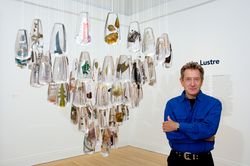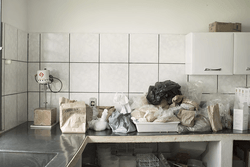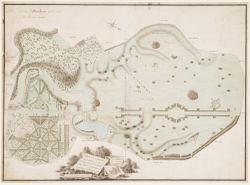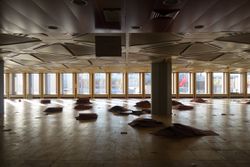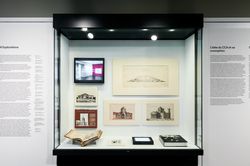Sensations urbaines
Sensations urbaines explore les perceptions et phénomènes urbains traditionnellement négligés, réprimés ou même dépréciés. Récusant la domination de l’impression visuelle dans l’environnement urbain, l’exposition, qui propose une réinterprétation des qualités latentes de la ville, offre une analyse complexe des commodités, des systèmes de communication et des dimensions(...)
Salles principales
26 octobre 2005 au 10 septembre 2006
Sensations urbaines
Actions:
Description:
Sensations urbaines explore les perceptions et phénomènes urbains traditionnellement négligés, réprimés ou même dépréciés. Récusant la domination de l’impression visuelle dans l’environnement urbain, l’exposition, qui propose une réinterprétation des qualités latentes de la ville, offre une analyse complexe des commodités, des systèmes de communication et des dimensions(...)
Salles principales
Gilles Clément
Dans le cadre de l’exposition Environnement : manières d’agir pour demain (2006), l’ingénieur horticole et paysagiste français Gilles Clément présente ses projets et ses théories. L’exposition propose un changement de perspective où l’environnement devient le point de départ d’une réflexion et non nos exigences d’humains envers ce dernier. Gilles Clément a réalisé de(...)
Théâtre Paul-Desmarais
19 octobre 2006
Gilles Clément
Actions:
Description:
Dans le cadre de l’exposition Environnement : manières d’agir pour demain (2006), l’ingénieur horticole et paysagiste français Gilles Clément présente ses projets et ses théories. L’exposition propose un changement de perspective où l’environnement devient le point de départ d’une réflexion et non nos exigences d’humains envers ce dernier. Gilles Clément a réalisé de(...)
Théâtre Paul-Desmarais
Alors que le climat de la Terre atteint un état d’instabilité constante, la prise de conscience de l’impact du réchauffement planétaire sur les droits de l’homme et l’augmentation des conflits sociaux, ne fait que s’accentuer. Une moindre attention a été accordée aux façons dont la violence politique et l’abus de droits humains, dans le passé comme dans le présent,(...)
Théâtre Paul-Demarais
1 décembre 2016, 18h
Dans les frontières du changement climatique (Vers une politique des droits non humains)
Actions:
Description:
Alors que le climat de la Terre atteint un état d’instabilité constante, la prise de conscience de l’impact du réchauffement planétaire sur les droits de l’homme et l’augmentation des conflits sociaux, ne fait que s’accentuer. Une moindre attention a été accordée aux façons dont la violence politique et l’abus de droits humains, dans le passé comme dans le présent,(...)
Théâtre Paul-Demarais
Les jardins de Grande-Bretagne et leurs bâtiments ont joué un rôle important dans l’art et la culture britanniques au cours des quatre derniers siècles, et ils ont influencé les architectes et architectes paysagistes d’Europe et d’Amérique du Nord. L’exposition Une Arcadie anglaise, 1600-1990 rassemble des documents sur l’histoire de ces jardins et bâtiments. Les 125(...)
Salles principales
12 février 1992 au 19 avril 1992
Une arcadie anglaise, 1600-1990 : jardins et bâtiments sous la garde du National Trust avec des œuvres tirées des collections du CCA
Actions:
Description:
Les jardins de Grande-Bretagne et leurs bâtiments ont joué un rôle important dans l’art et la culture britanniques au cours des quatre derniers siècles, et ils ont influencé les architectes et architectes paysagistes d’Europe et d’Amérique du Nord. L’exposition Une Arcadie anglaise, 1600-1990 rassemble des documents sur l’histoire de ces jardins et bâtiments. Les 125(...)
Salles principales
Au cours de la Seconde Guerre mondiale, expositions et publications ont joué un rôle de premier plan dans l’effort de guerre. Elles ont été organisées et diffusées partout dans le monde comme des moments de réflexion et de propagande, des productions d’une approche disciplinaire de l’architecture et de l’urbanisme. Le choix des objets exposés découle des recherches de(...)
Vitrines
13 avril 2011 au 18 septembre 2011
Une guerre de papier: Images et mots, 1939-1945
Actions:
Description:
Au cours de la Seconde Guerre mondiale, expositions et publications ont joué un rôle de premier plan dans l’effort de guerre. Elles ont été organisées et diffusées partout dans le monde comme des moments de réflexion et de propagande, des productions d’une approche disciplinaire de l’architecture et de l’urbanisme. Le choix des objets exposés découle des recherches de(...)
Vitrines
Rotor Deconstruction
Maarten Gielen présente les activités de Rotor, un groupe d’architectes, de designers et d’autres professionnels intéressés par les flux de matériaux dans l’industrie et la construction. Le groupe travaille en particulier sur les ressources, les déchets, l’utilisation et la réutilisation des matériaux. Rotor diffuse des stratégies innovatrices de récupération et de(...)
4 février 2016
Rotor Deconstruction
Actions:
Description:
Maarten Gielen présente les activités de Rotor, un groupe d’architectes, de designers et d’autres professionnels intéressés par les flux de matériaux dans l’industrie et la construction. Le groupe travaille en particulier sur les ressources, les déchets, l’utilisation et la réutilisation des matériaux. Rotor diffuse des stratégies innovatrices de récupération et de(...)
archives
Niveau de description archivistique:
Fonds
Fonds Robert Duchesnay
AP115
Résumé:
Le Fonds Robert Duchesnay consiste en une série de photographies montrant les divers structure (principalement des dômes géodésiques) conçus ou influencée par R. Buckminster Fuller. Les photographies, prises par l'artiste et photographe montréalais Robert Duchesnay, ont été créées entre 1985 et 1992.
1985-1992
Fonds Robert Duchesnay
Actions:
AP115
Résumé:
Le Fonds Robert Duchesnay consiste en une série de photographies montrant les divers structure (principalement des dômes géodésiques) conçus ou influencée par R. Buckminster Fuller. Les photographies, prises par l'artiste et photographe montréalais Robert Duchesnay, ont été créées entre 1985 et 1992.
archives
Niveau de description archivistique:
Fonds
1985-1992
Sous-série
AP022.S3.SS3
Description:
Sub-series documents public relations, marketing activities and collaborations of the offices of Erickson / Massey and Arthur Erickson Architects in Vancouver, British columbia, and Toronto, Ontario. The material was intended for media and press releases, publications, photographs and information requests, presentations, publicity and marketing brochures, and includes project descriptions, photographs and slides, magazine articles and clippings, publication drawings, galley proofs for books and a Life Magazine article on the Graham House, correspondence, and printing plates for a publicity brochure. Sub-series also documents Erickson / Massey and Arthur Erickson Architects collaboration with Francisco Imported Furniture Ltd the company of Francisco Leopoldo Kripacz (b. 8 April, 1942 - d. 3 August, 2000). Kripacz was born in Caracas, Venezuela, educated in Europe, the United States, and studied design in Vancouver and New York. He also went to the University of British Columbia for a Bachelor of Commerce degree in 1964. He became a resident Canadian in 1961, and a Canadian citizen in 1973. In 1964 he founded an interior design and furniture import business in Vancouver with Arthur Erickson, and opened a showroom in Montreal (550 Sherbrooke St. West), in 1965. Kripacz designed the exhibition unit in Habitat 67 (by architect Moshe Safdie) for the 1967 World Exposition in Montreal, and created interiors for a private clientel as well as for many of Arthur Erickson's buildings. The latter included the Helmut Eppich House and Erickson's own residence in Vancouver, the Hilborn Residence in Ontario, the Prime Minister's office and resdence in Ottawa, the UBC Faculty Club, the Macmillan Blodel Bulding, Vancouver, the Bank of Canada Headquarters in Ottawa, the Student Union Building at Queen's University, Kingston, the Provincial Law Courts in Robson Square, Vancouver, Roy Thomson Hall and the Tech Mining offices in Toronto, the Canadian Chancery in Washington, D.C., amongst others. Material related to Francisco Imported Furniture Ltd Sub-series also contains professional correspondence with Arthur Erickson Architect, financial documents of Francisco Imported Furniture Ltd, furniture design proposals, photographs and personal correspondance files of Francisco Kripacz.
1967-1988
Public relations, marketing and collaborations
Actions:
AP022.S3.SS3
Description:
Sub-series documents public relations, marketing activities and collaborations of the offices of Erickson / Massey and Arthur Erickson Architects in Vancouver, British columbia, and Toronto, Ontario. The material was intended for media and press releases, publications, photographs and information requests, presentations, publicity and marketing brochures, and includes project descriptions, photographs and slides, magazine articles and clippings, publication drawings, galley proofs for books and a Life Magazine article on the Graham House, correspondence, and printing plates for a publicity brochure. Sub-series also documents Erickson / Massey and Arthur Erickson Architects collaboration with Francisco Imported Furniture Ltd the company of Francisco Leopoldo Kripacz (b. 8 April, 1942 - d. 3 August, 2000). Kripacz was born in Caracas, Venezuela, educated in Europe, the United States, and studied design in Vancouver and New York. He also went to the University of British Columbia for a Bachelor of Commerce degree in 1964. He became a resident Canadian in 1961, and a Canadian citizen in 1973. In 1964 he founded an interior design and furniture import business in Vancouver with Arthur Erickson, and opened a showroom in Montreal (550 Sherbrooke St. West), in 1965. Kripacz designed the exhibition unit in Habitat 67 (by architect Moshe Safdie) for the 1967 World Exposition in Montreal, and created interiors for a private clientel as well as for many of Arthur Erickson's buildings. The latter included the Helmut Eppich House and Erickson's own residence in Vancouver, the Hilborn Residence in Ontario, the Prime Minister's office and resdence in Ottawa, the UBC Faculty Club, the Macmillan Blodel Bulding, Vancouver, the Bank of Canada Headquarters in Ottawa, the Student Union Building at Queen's University, Kingston, the Provincial Law Courts in Robson Square, Vancouver, Roy Thomson Hall and the Tech Mining offices in Toronto, the Canadian Chancery in Washington, D.C., amongst others. Material related to Francisco Imported Furniture Ltd Sub-series also contains professional correspondence with Arthur Erickson Architect, financial documents of Francisco Imported Furniture Ltd, furniture design proposals, photographs and personal correspondance files of Francisco Kripacz.
sub-series
1967-1988
Projet
AP075.S1.1957.PR05
Description:
This project series documents Cornelia Hahn Oberlander's landscape project for the garden of Mr & Mrs Wong residence on South Cambie Street in Vancouver. Oberlander worked on this project in 1954-1956 with architect Harry Lee from Duncan McNab’s office. Oberlander’s concept for the landscape was to create a garden with rock outcropping, due to the complicated site on which the house was built. She “designed a main walkway paralleling the side yard property line to connect S. Cambie Street to the rear alley.” [1] The walkway, decorated with flowerpots, leads to a u-shaped paved courtyard with a central lawn area with decorative rocks. Between the expose rock at the front of the property and the façade of the house, she created a lawn area with a pathway of steppingstones at the side of house leading to the backyard. The project series contains only six drawings, including two sketches, two design development drawings of landscape plans, and working drawings for the residence used as reference. The project is also documented through photographs of the residence and the landscaping, and a plant list. Source: [1] Herrington, Susan. Cornelia Hahn Oberlander: Making the Modern Landscape, University of Virginia Press, 2014, 304 pages. p. 88.
1957-1958
W.K. Wong Residence, Vancouver, British Columbia (1957-1958)
Actions:
AP075.S1.1957.PR05
Description:
This project series documents Cornelia Hahn Oberlander's landscape project for the garden of Mr & Mrs Wong residence on South Cambie Street in Vancouver. Oberlander worked on this project in 1954-1956 with architect Harry Lee from Duncan McNab’s office. Oberlander’s concept for the landscape was to create a garden with rock outcropping, due to the complicated site on which the house was built. She “designed a main walkway paralleling the side yard property line to connect S. Cambie Street to the rear alley.” [1] The walkway, decorated with flowerpots, leads to a u-shaped paved courtyard with a central lawn area with decorative rocks. Between the expose rock at the front of the property and the façade of the house, she created a lawn area with a pathway of steppingstones at the side of house leading to the backyard. The project series contains only six drawings, including two sketches, two design development drawings of landscape plans, and working drawings for the residence used as reference. The project is also documented through photographs of the residence and the landscaping, and a plant list. Source: [1] Herrington, Susan. Cornelia Hahn Oberlander: Making the Modern Landscape, University of Virginia Press, 2014, 304 pages. p. 88.
Project
1957-1958
À l’occasion des 90 ans de Phyllis Lambert, cette exposition offre un aperçu autobiographique de l’évolution des idées de la fondatrice du CCA et de son travail architectural, éditorial, curatorial et d’activisme. L’exposition met en lumière l’engagement résolu de Phyllis Lambert envers la ville et la recherche intellectuelle, en présentant des documents de la collection(...)
Vitrines
18 janvier 2017 au 11 juin 2017
Phyllis Lambert : 75 ans au travail
Actions:
Description:
À l’occasion des 90 ans de Phyllis Lambert, cette exposition offre un aperçu autobiographique de l’évolution des idées de la fondatrice du CCA et de son travail architectural, éditorial, curatorial et d’activisme. L’exposition met en lumière l’engagement résolu de Phyllis Lambert envers la ville et la recherche intellectuelle, en présentant des documents de la collection(...)
Vitrines

